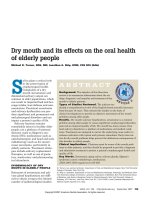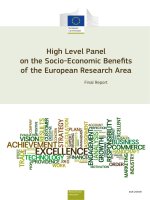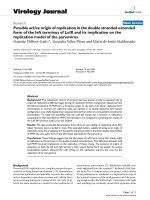Decision making behaviour and its influence on the socio economic performance of farm households in H-K Region of Karnataka, India
Bạn đang xem bản rút gọn của tài liệu. Xem và tải ngay bản đầy đủ của tài liệu tại đây (289.2 KB, 6 trang )
Int.J.Curr.Microbiol.App.Sci (2019) 8(9): 1756-1761
International Journal of Current Microbiology and Applied Sciences
ISSN: 2319-7706 Volume 8 Number 09 (2019)
Journal homepage:
Original Research Article
/>
Decision Making Behaviour and its Influence on the Socio Economic
Performance of Farm Households in H-K Region of Karnataka, India
N. S. Nagesh1*, Amrutha T. Joshi1, Jagruti B. Deshmanya1, G. M. Hiremath1,
G. B. Lokesh1, D. M. Chandargi2 and N. Ananda3
1
Department of Agricultural Economics, College of Agriculture, UAS, Raichur, India
2
Department of Agricultural Extension Education, College of Agriculture,
UAS, Raichur, India
3
Department of Agronomy, College of Agriculture, UAS, Raichur, India
*Corresponding author
ABSTRACT
Keywords
Decision making
behaviour, Social
performance,
Economic
performance,
Institutional
participation
Article Info
Accepted:
20 August 2019
Available Online:
10 September 2019
Agriculture plays a predominant role in Indian economy and contributes 18 per cent to
India’s gross domestic product. Farmers have to take series of decisions to make
farming a viable enterprise. A study was planned to know the decision making
behaviour and its influence on the socio economic performance of farm households.
The respondents were chosen from three districts viz. Raichur, Gulbarga and Koppal.
Thirty farmers from rainfed situation and thirty farmers from irrigated situation were
chosen from each district making a total sample size of 180. The results revealed that
Number of family members, achievement motivation score and decision making
behaviour score were found to be significantly influencing the annual agricultural
income. As the decision making behaviour score increases by one unit the annual
agricultural income increases by Rs 9231.28. Type of risk behaviour was not
significant implying that whether farmers were risk loving, risk averse or risk neutral
did not influence the annual agricultural income significantly. Irrigated rainfed
dummy, number of years of schooling, achievement motivation score, risk orientation
score and mass media participation were found to be significantly influencing the
institutional participation. Number of family members and decision making behaviour
score were found to be significantly influencing the total annual income.
Introduction
Agriculture is the most important sector of
Indian Economy. Indian agriculture sector
accounts for 18 per cent of India's gross
domestic product (GDP) and provides
employment to 50% of the countries
workforce. India is the world’s largest
producer of pulses, rice, wheat, spices and
spice products. India has many areas to choose
for business such as dairy, meat, poultry,
fisheries and food grains etc. For achieving
1756
Int.J.Curr.Microbiol.App.Sci (2019) 8(9): 1756-1761
self-sufficiency in food production, farmers
play an important role as stakeholder in our
country. Hence, farmers role is imperative to
increase food production and that could be
seen in terms of influencing farmers to accept
and adopt new technology to increase their
farm income, modernizing the farm through
improved farm machinery, developing the
farm with irrigation facilities, strengthening
post-harvest operations, timely marketing of
produce to fetch attractive prices and
encouraging savings for investment on farm
development, education of children etc.,
Farmers in developing countries are frequently
exposed to the uncertainties of weather, prices
and disease. Many farmers live on the edge of
extreme uncertainty, sometimes falling just
below, and sometimes rising just above the
threshold of survival. Farmers do not know
whether rainfall will be good or bad over a
season; they do not know the prices they will
receive for produce sold; and they do not
know whether their crops will be infected by
disease. These risks are not under the control
of farmers but some farmers have developed
ways of coping and managing them (Kahan,
2008).
Farmers make decisions every day that affect
farming operations. Many of the factors that
affect the decisions they make cannot be
predicted with complete accuracy; this is risk.
Farming has become increasingly risky as
farmers become more commercial. Farmers
need to understand risk and have risk
management skills to better anticipate
problems and reduce consequences.
Decision-making is the principal activity of
management. All decisions have outcomes or
consequences. However, in most situations the
outcome of a decision cannot be predicted.
The more complex the risk, the more difficult
it becomes for farmers to make an informed
decision. For effective decisions to be taken,
farmers need information on many aspects of
the farming business. Farmers have to find
ways of dealing with risk and protecting
themselves from the uncertainties of the
future.
Decision theory (or the theory of choice) is the
study of the reasoning underlying an agent's
choices. Decision theory can be broken into
two branches: normative decision theory,
which gives advice on how to make the best
decisions, given a set of uncertain beliefs and
a set of values and descriptive decision theory,
which analyzes how existing, possibly
irrational agents actually make decisions.
It was planned to conduct a study to know the
impact of Decision making behaviour on socio
economic performance of farm households in
Hyderabad Karnataka region of Karnataka
Materials and Methods
The study was carried out in the Hyderabad
Karnataka region. Raichur, Gulbarga and
Koppal districts were randomly selected to
represent the Hyderabad-Karnataka region.
From each district, two taluks were selected,
such that one of them represented the rainfed
region and the other represented the irrigated
region, based on the net irrigated area. From
each of the selected taluks, two Gram
panchayats were selected randomly, and from
each panchayat a village was selected
randomly. Thus, totally 12 villages were
selected for the study. From each selected
village fifteen farmers were selected using
simple random sampling method. Thus, the
total sample size constituted of 180
respondents.
Annual agricultural income
Income obtained from crop production,
horticultural crops, livestock and other
subsidiary enterprises was considered to arrive
1757
Int.J.Curr.Microbiol.App.Sci (2019) 8(9): 1756-1761
at annual agricultural income. The respondents
were grouped into three categories using mean
and standard deviation as measure of check.
Institutional participation
Institutional participation was measured
considering their membership in formal
groups, informal groups and technical
institutions. One score was awarded for
possessing membership in each of the
organization. The respondents were grouped
into three categories using mean and standard
deviation as measure of check.
Total annual income
Total annual income was quantified
considering the agricultural income, income
from business, wages, salary and income from
migration. The respondents were grouped into
three categories using mean and standard
deviation as measure of check.
Results and Discussion
Factors influencing Agricultural Income
In the first stage regression was run taking
annual agriculture income as dependent
variable and irrigated rainfed dummy, age,
number of years of schooling, number of
family members, family type, achievement
motivation score, risk orientation score,
economic motivation score, decision making
behaviour score, type of risk behaviour and
mass media participation score as independent
variables (Table 1). Number of family
members, achievement motivation score and
decision making behaviour score were found
to be significantly influencing the annual
agricultural income. Number of family
members had a negative influence while both
achievement motivation score and decision
making behaviour score had a positive
influence on annual agricultural income. For
every one additional member in the family, the
annual agricultural income decreases by Rs
11018.93. This finding is in line with our
apriori expectation that with every additional
member in the family, the annual agricultural
income decreases because the burden on the
fixed amount of money increases. For every
one unit increase in the achievement
motivation score the annual agricultural
income increases by Rs 4809.70. With the
increase in the achievement motivation score
the farmers ability to take more challenges
increases, which in turn increases their annual
agricultural income. As the decision making
behaviour score increases by one unit the
annual agricultural income increases by Rs
9231.28. An improvement in the decision
making score implies the ability of the farmer
to take appropriate decisions in right time,
considering the resource constraints and thus
leads to enhancement in agricultural income.
The findings that age and education were not
significant determinants of agricultural income
were not in conformity with Mabeet al.,
(2010). Type of risk behaviour was not
significant implying that whether farmers
were risk loving, risk averse or risk neutral did
not influence the annual agricultural income
significantly.
In this regression, 68.10 per cent of the
variation in the dependent variable (annual
agricultural income) was explained by the
independent variables considered in the
model. The R square of 68.10 per cent implies
that there exists greater scope for including
some more appropriate independent variables
in the model.
Factors
influencing
participation
Institutional
In the first stage regression was run taking
institutional participation as dependent
variable and irrigated rainfed dummy, age,
number of years of schooling, number of
1758
Int.J.Curr.Microbiol.App.Sci (2019) 8(9): 1756-1761
family members, family type, achievement
motivation score, risk orientation score,
economic motivation score, decision making
behaviour score, type of risk behaviour and
mass media participation score as independent
variables (Table 2). Irrigated rainfed dummy,
number of years of schooling, achievement
motivation score, risk orientation score and
mass media participation were found to be
significantly influencing the institutional
participation. Achievement motivation score
had a negative influence while all other
variables, irrigated rainfed dummy, number of
years of schooling, risk orientation score and
mass media participation had a positive
influence on institutional participation.
Irrigated farmers are likely to have higher
institutional participation to the tune of 0.67
units in comparison rainfed farmers. The
irrigated farmers earn higher income per acre
in comparison to rainfed farmers and thus the
participation in group activities is also higher
among irrigated farmers in comparison to
rainfed farmers. As the number of years of
schooling increases by one year the
institutional participation increases by 0.07
units. This observation is in line with our
apriori expectation that with increased
education, farmers gain more knowledge and
awareness leading to higher institutional
participation. As the achievement motivation
score increases by one unit, the institutional
participation decreases by 0.07 units. As the
achievement motivation increases, the farmers
become more independent and thus their
institutional participation decreases. As the
mass media participation score increases by
one unit, the institutional participation
increases by 0.13 units. Farmers receive latest
information from various mass media sources
and discuss about them in groups, thereby
encouraging institutional participation. As the
risk orientation score increases by one unit,
the institutional participation increases by 0.16
units. As the farmer face more risk, they tend
to mitigate them by participation in group
activities, thereby increasing
participation.
institutional
In this regression, 49.50 per cent of the
variation in the dependent variable
(Institutional participation) was explained by
the independent variables considered in the
model. The R square of 49.50 per cent implies
that there exists greater scope for including
some more appropriate independent variables
in the model.
Factors influencing total annual income
In the first stage, regression was run taking
total annual income as dependent variable and
irrigated rainfed dummy, age, number of years
of schooling, number of family members,
family type, achievement motivation score,
risk orientation score, economic motivation
score, decision making behaviour score, type
of risk behaviour and mass media participation
score as independent variables (Table 3).
Number of family members and decision
making behaviour score were found to be
significantly influencing the total annual
income. Number of family members had a
negative influence while decision making
behaviour score had a positive influence on
total annual income. For every one additional
member in the family, the total annual income
decreases by Rs 6220.25. This finding is in
line with our apriori expectation that with
every additional member in the family, the
total annual income decreases because the
burden on the fixed amount of money
increases.
As the decision making behaviour score
increases by one unit the total annual income
increases by Rs 9528.55. An improvement in
the decision making score implies an
improvement in the ability of the farmer to
take appropriate decisions in right time,
leading to enhanced total annual income.
1759
Int.J.Curr.Microbiol.App.Sci (2019) 8(9): 1756-1761
Table.1 Factors influencing Agricultural Income (Economic performance)
Independent variables
Intercept
Irrigated rainfed dummy (D1)
Age (yrs)
No. of years of schooling (yrs)
Family type dummy (D2)
Achievement motivation score
Risk orientation score
Economic motivation score
Decision making behaviour score
Type of risk behaviour (D3)
Type of risk behaviour (D4)
Mass media participation score
R square
Adjusted R square
Dependent Variable: Agricultural income (₹)
Coefficients
t value
-93319.59*
-1.74
14645.01
1.22
-521.62
-1.29
-795.07
-0.56
13047.99
0.84
4809.70**
2.21
-9469.33
-1.42
1644.29
0.26
9231.28***
14.07
22807.69
1.18
11143.25
0.96
2282.76
1.27
0.681
0.658
Note: *** = Significant at 1 % level
** = Significant at 5 % level
* = Significant at 10 % level
Table.2 Factors influencing Institutional Participation (Social performance)
Independent variables
Intercept
Irrigated rainfed dummy (D1)
Age (yrs)
No. of years of schooling (yrs)
No. of family members (No.)
Family type dummy (D2)
Achievement motivation score
Risk orientation score
Economic motivation score
Type of risk behaviour (D3)
Type of risk behaviour (D4)
Mass media participation score
Decision making behaviour score
R square
Adjusted R square
Dependent Variable: Institutional Participation
Coefficients
t value
2.99***
3.77
0.67***
3.77
0.00
-0.38
0.07***
3.30
0.02
0.59
-0.33
-1.45
-0.07**
-2.26
0.16*
1.67
-0.03
-0.32
-0.18
-0.63
0.11
0.62
0.13***
4.75
0.0004
0.40
0.495
0.459
Note: *** = Significant at 1 % level
** = Significant at 5 % level
* = Significant at 10 % level
1760
Int.J.Curr.Microbiol.App.Sci (2019) 8(9): 1756-1761
Table.3 Factors influencing Total Income (Economic performance)
Independent variables
Intercept
Irrigated rainfed dummy (D1)
Age (yrs)
No. of years of schooling (yrs)
Family type dummy (D2)
Achievement motivation score
Risk orientation score
Economic motivation score
Type of risk behaviour (D3)
Type of risk behaviour (D4)
Mass media participation score
Decision making behaviour score
R square
Adjusted R square
Dependent Variable: Total annual income (₹)
Coefficients
t value
-59162.15
-0.81
15921.72
0.97
128.47
0.23
2402.94
1.24
12228.87
0.58
-1201.29
-0.41
-1649.94
-0.18
5643.84
0.64
37536.53
1.42
17816.28
1.12
2313.90
0.94
9528.55***
10.63
0.569
0.538
In this regression, 56.90 per cent of the
variation in the dependent variable (total
annual income) was explained by the
independent variables considered in the
model. The R square of 56.90 per cent implies
that there exists greater scope for including
some more appropriate independent variables
in the model.
Decision making behaviour has a greater
influence on annual agricultural income,
institutional participation and total income of
the sample farmers as found in the study
results. Hence, the decision making behaviour
plays a vital role in the socio-economic
performance of farm households in study area.
Therefore, it is important to adopt appropriate
strategies for upgradation of decision making
behaviour among farm households.
References
Kahan, D., 2008, Managing risk in farming.
Farm management extension guide 3,
Food and Agricultural Organization,
Rome.
Mabe, L. K., Antwi, M. A. and Oladele, O. I.,
2010, Factors influencing farm income
in livestock producing communities of
North-West Province, South Africa.
Livestock Res. Rural Dev., 22(8).
How to cite this article:
Nagesh, N. S, Amrutha T. Joshi, Jagruti B. Deshmanya, G. M. Hiremath, G. B. Lokesh, D. M.
Chandargi and Ananda, N. 2019. Decision Making Behaviour and its Influence on the Socio
Economic Performance of Farm Households in H-K Region of Karnataka, India.
Int.J.Curr.Microbiol.App.Sci. 8(09): 1756-1761. doi: />
1761









